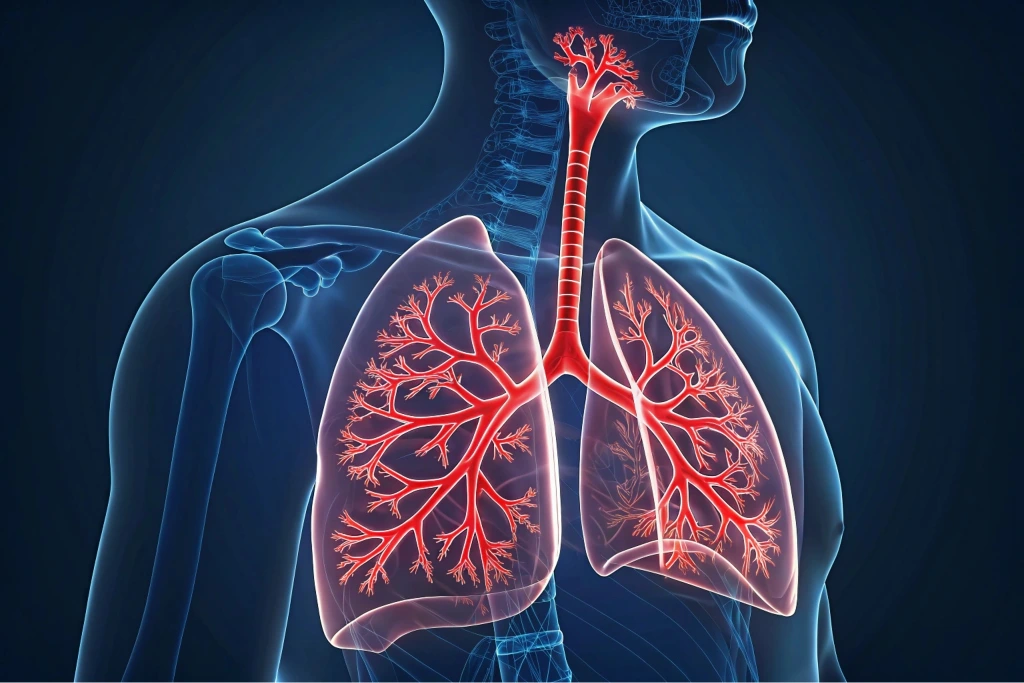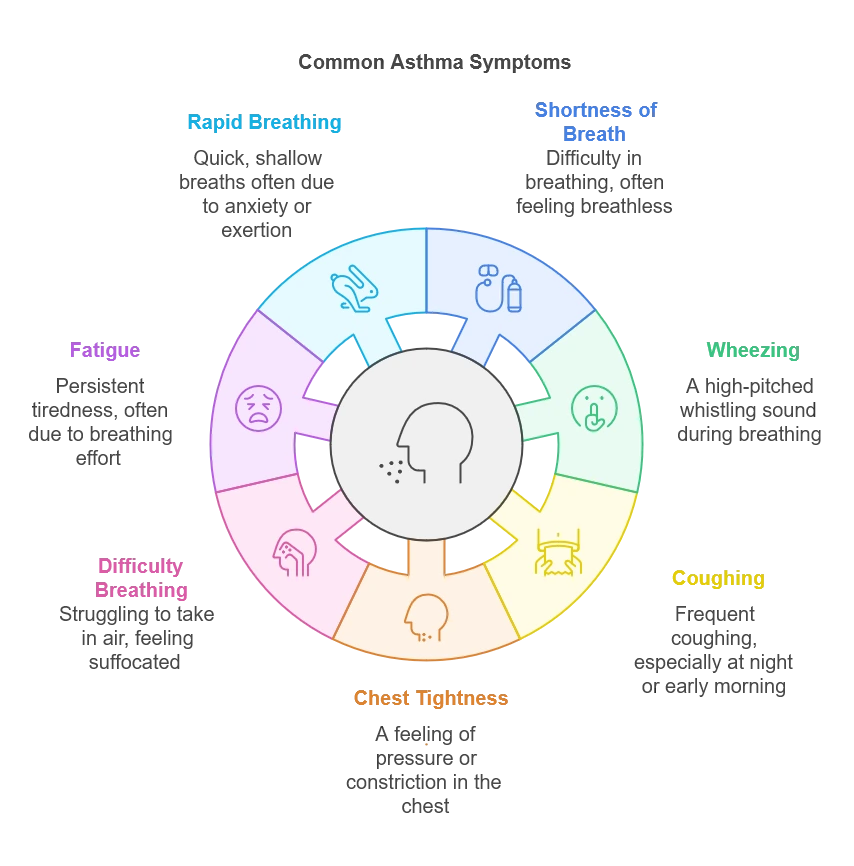Asthma Signs and Symptoms
Asthma is not a disease but a chronic condition that affects the respiratory system. It is characterized by difficulty in breathing, usually triggered by identifiable stressors or agents. Asthma sufferers experience constriction of the airways (the bronchial tubes leading to the lungs), which reduces airflow in and out of the lungs. This results in airways becoming inflamed, narrow, and filled with mucus, leading to symptoms such as difficult breathing, panic, shortness of breath, vomiting, coughing, wheezing, chest tightness, and sometimes suffocation.

Did You Know?
- More than 15 million Americans, both children and adults, have asthma.
- Triggers of asthma attacks have grown rapidly, with air quality (allergens in the air, pollen, pet dander, smoke, etc.) taking the lead.
- Asthma is now a real health hazard, especially in metropolitan cities.
For a list of the worst cities for asthma, you can refer to FOXnews 20 Worst Cities For Asthma. Hope your city does not make the list!
While there is no known cause or cure for the condition (because it is not a disease), triggers of an attack are constantly growing. Triggers are often identifiable, and the condition can be controlled to reduce the intensity and frequency of attacks. Usually, children outgrow the condition.
Types of Asthma
All types of asthma can be grouped into two broad categories: extrinsic and intrinsic.
Extrinsic Asthma
Extrinsic asthma, the more common type, is a respiratory condition triggered by allergic reactions to external agents such as:
- Molds
- Pollen
- Dust mites
- Pet hair
- Drugs (especially aspirin)
- Smoke (cigarette smoke, smoke from fireplaces or wood stoves)
- Exercise
- Foods (e.g., eggs, shellfish, garlic, wheat, sugar, cow’s milk, soy, peanuts, salads, and fresh fruits)
- Thunderstorms
- Cockroach excrement
- Rat urine
- Athlete’s foot (trichophyton fungus)
- Perfume, including those smelly perfume-sample strips bound into magazines
- Food additives such as food colors, preservatives, and MSG (monosodium glutamate)
Intrinsic Asthma
Intrinsic asthma is triggered by internal factors such as:
- Genetics
- Infections (e.g., colds and flu)
- Pollutants (e.g., heavy metals)
- Vaccinations
- Stress (usually emotional)
- Adrenal dysfunction
Intrinsic asthma is often connected to one or more organs in the body. This is frequently true with heart trouble and kidney disease. In most cases, intrinsic asthma improves only when the affected organ is nourished and/or treated.
Asthma Triggers
Any number of things can spark an asthma attack, from allergies to thunderstorms, and even a memory. Identifying asthma triggers is the first step to gaining control of your asthma.
The most common trigger is allergies. Half of all people over age 30 who have asthma also have allergies. Triggers of asthma symptoms vary for different people. However, one thing is consistent with attacks: airways come in contact with a trigger; the airways become inflamed, narrow, and fill with mucus.
Common Asthma Triggers
| Category | Triggers |
|---|---|
| Allergens | Pollen, dust mites, pet dander, mold |
| Irritants | Tobacco smoke, air pollution, strong odors, fumes |
| Weather | Cold air, dry wind, thunderstorms |
| Exercise | Physical exertion |
| Emotions | Stress, strong emotions |
| Medications | Aspirin, NSAIDs, beta-blockers |
| Foods | Sulfites in food and drinks, MSG |
| Infections | Respiratory infections, colds, flu |
| Gastroesophageal Reflux Disease (GERD) | Acid reflux |
Determining the prevailing factors at the onset of an attack is the first step to identifying an asthma trigger. Although there are many different asthma triggers, you may not react to all of them. Some people have only one trigger, while others have many. A history of reaction, and skin or blood testing can help identify triggers.
Using a peak flow meter may also help narrow down trigger suspects. A peak flow meter measures how much and how quickly air is exhaled from the lungs. It can alert you to changes in your breathing and the onset of asthma symptoms.
Once triggers are identified, for Pete’s sake, avoid them! Some asthma sufferers still deny their pet’s hair is a trigger for them. Household cleaners too, are another trigger asthma sufferers do not readily admit to. Hello ladies, that’s one way to get your husbands to do the scrubbing!
Airborne triggers make some cities more risky than others. See the 20 worst cities for asthma.
Asthma Control
Controlling asthma requires paying attention to various body systems. Asthma is both a respiratory problem and a nervous/glandular system problem. Asthmatics typically have respiratory congestion associated with anxiety or panic which causes constriction of the airways. Most asthmatics also have a hiatal hernia, which is also a symptom of nervous stress.
Decongestants, expectorants, and other techniques can help you gain control over asthma so you can thrive. For more information see “exercising with asthma” and “tips on respiratory health.”
Strengthening the digestive system may also be required. Digestive enzymes or digestive tonics are often helpful. Asthma sufferers almost always have acid reflux, GERD (Gastro Esophageal Reflux Disease), heartburn, and insomnia; all of which are related to the digestive, respiratory, and nervous systems.
FAQ: Top 10 Asthma Questions
1. What is asthma?
Asthma is a chronic condition that affects the airways leading to the lungs. It causes inflammation, narrowing, and excess mucus production, making it difficult to breathe. Asthma is not a disease but a respiratory problem that can be managed with proper care.

2. What are the symptoms of asthma?
Common symptoms of asthma include:
- Shortness of breath
- Wheezing
- Coughing, especially at night or early morning
- Chest tightness or pain
- Difficulty breathing
- Fatigue
- Rapid breathing
3. What triggers asthma?
Asthma can be triggered by a variety of factors, including:
- Allergens: Pollen, dust mites, pet dander, mold
- Irritants: Tobacco smoke, air pollution, strong odors, fumes
- Weather: Cold air, dry wind, thunderstorms
- Exercise: Physical exertion
- Emotions: Stress, strong emotions
- Medications: Aspirin, NSAIDs, beta-blockers
- Foods: Sulfites in food and drinks, MSG
- Infections: Respiratory infections, colds, flu
- Gastroesophageal Reflux Disease (GERD): Acid reflux
4. What is an asthma attack?
An asthma attack occurs when the airways become inflamed, narrow, and fill with mucus, making it difficult to breathe. Symptoms can range from mild to severe and may include wheezing, coughing, chest tightness, and shortness of breath.
5. How is asthma diagnosed?
Asthma is typically diagnosed through a combination of methods:
- Medical history and physical examination
- Lung function tests, such as spirometry and peak flow measurement
- Allergy testing
- Chest X-ray or CT scan
- Blood tests to check for eosinophils (a type of white blood cell)
6. What are the types of medications for asthma?
Medications for asthma can be categorized into two main types:
- Quick-relief medications: Inhalers like albuterol that provide immediate relief during an asthma attack.
- Long-term control medications: Inhaled corticosteroids, long-acting beta-agonists (LABAs), leukotriene modifiers, and combination inhalers that help manage asthma symptoms over time.
7. Can asthma be cured?
Asthma is a chronic condition that cannot be cured, but it can be effectively managed. With proper treatment and lifestyle adjustments, most people with asthma can lead active and healthy lives.
8. Is it safe to exercise with asthma?
Yes, it is generally safe to exercise with asthma. Regular physical activity can improve lung function and overall health. However, it’s important to use your asthma medications as prescribed and to warm up before exercising to reduce the risk of an asthma attack.
9. What is an asthma action plan?
An asthma action plan is a personalized plan developed by your healthcare provider to help you manage your asthma. It includes:
- Daily management strategies
- Instructions on how to recognize and handle worsening asthma symptoms
- Emergency protocols for severe asthma attacks
10. How can I prevent an asthma attack?
To prevent an asthma attack, consider the following steps:
- Identify and avoid your asthma triggers
- Take your asthma medications as prescribed
- Monitor your asthma symptoms regularly
- Maintain a healthy lifestyle with a balanced diet and regular exercise
- Follow your asthma action plan
- Stay informed about the latest asthma research and treatments
Tips for Controlling Asthma
- Identify and Avoid Triggers: Keep a diary to track what triggers your asthma and avoid those triggers as much as possible.
- Use Medications as Prescribed: Follow your doctor’s advice on using inhalers and other medications.
- Monitor Your Asthma: Use a peak flow meter to monitor your lung function and adjust your medications as needed.
- Maintain a Healthy Lifestyle: Eat a balanced diet, exercise regularly, and manage stress to keep your overall health in check.
- Stay Informed: Keep up-to-date with the latest research and treatments for asthma.
Control asthma; don’t let it control you.